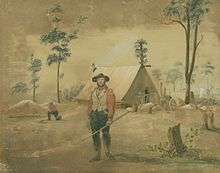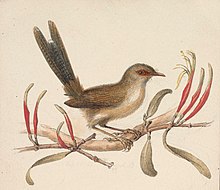Ludwig Becker (explorer)
Ludwig Becker (5 September 1808 – 29 April 1861) was a German artist, explorer and naturalist. He was born in Rödelheim near Frankfurt am Main. He moved to Australia in 1850, and was a member of the ill-fated Burke and Wills expedition. He died at the expedition's camp on the western bank of Koorliatto Waterhole, Bulloo River in 1861.
_SmallFiltered.jpg)
Early years
Becker was born at Rödelheim near Frankfurt am Main, Germany, in 1808. He left Germany in 1850. As was common practice at the time, he was referred to as Dr. Becker, but had not studied at a university.
His father was Ernst Friedrich Becker (1750–1826) and his mother was Amöne Eleonore Weber (1782–1819). Becker was the eldest of five children from this marriage. After his mother's death, Becker's father married Johanette Christiane Weber, a younger sister of his first wife. They had three more children.
- Ludwig Phillip Heinrich Becker (1808–1861)
- Friedrich Christian Becker (1809–1875)
- Karl Becker (1813–1850)
- Heinrich Leonard Becker (1815–1871)
- Bertha Becker (1817–1822)
- August Becker (1821–1887)
- Ferdinand Becker (1822–1913)
- Ernst Becker (1826–1888)
Australia

After some time in England he travelled from Liverpool in November 1850 on the ship Hannah via Pernambuco, Brazil,[1] and arrived in Launceston, Van Diemen's Land in early 1851. He was described by Lady Denison as "one of those universal geniuses who can do anything ... a very good naturalist, geologist ... draws and plays and sings, conjures and ventriloquises and imitates the notes of birds so accurately". From 1852 until 1854, while mining for gold in Bendigo, Becker made meteorological observations and produced sketches which he exhibited in Melbourne in April 1854. He became a council member of the Victorian Society of Fine Arts in 1856 and of the Philosophical Institute of Victoria in 1859, and was a leading member of the German Club. He corresponded with ornithologist and zoologist John Gould, known as the father of bird study in Australia, on the lyrebird, and was one of the first to try to raise a lyrebird chick and sent sketches of the egg to ornithologists in Germany and France.
He illustrated botanical works for Ferdinand von Mueller including Fragmenta phytographiae Australiae (1858–82) and The Plants Indigenous to the Colony of Victoria (1860–65).[2]
Burke and Wills expedition
His scientific knowledge and artistic ability qualified him for selection as a member[3] of the Victorian Exploring Expedition in 1860–61, which has since become known as the Burke and Wills expedition. It was organised by the Philosophical Institute of Victoria which in 1860 became the Royal Society of Victoria.
The Burke and Wills expedition was led by Robert O'Hara Burke, a police superintendent in the Castlemaine, Victoria district. In 1860 he was given leave to take command of the exploring expedition to cross the continent from Melbourne in the south to the Gulf of Carpentaria in the north. The objectives of the expedition were hazy and its route, from Cooper Creek to the Gulf of Carpentaria, was decided less than a month before it set out. Burke's instructions, sent after him because they were not ready at the time, were lengthy and vague. The real object of the expedition appears to have been to snatch from the South Australian explorer, John McDouall Stuart, the honour of making the first south-north crossing of the continent. Sir Henry Barkly, Governor of Victoria 1856–1863, described it as "the glorious race across the continent between the expeditions fitted out in this and the adjacent colony of South Australia".
The Burke and Wills expedition was the most expensive in the history of Australian exploration. It cost over £60,000 and would eventually claim seven lives. The expedition was provided with more than two dozen camels, imported complete with cameleers. There were horses and wagons, food for two years and lavish equipment. The party consisted of five officers: Burke, Landells as second-in-command, and William John Wills, third-in-command and surveyor and meteorologist and the two German scientific officers: Becker and Hermann Beckler, medical officer and botanist. The expedition also included a foreman, nine assistants and the camel-drivers.
The expedition left Melbourne on 20 August 1860 and made progress through the settled districts of Victoria to Swan Hill and Balranald and reached Menindee on the Darling River at the beginning of October. Burke was in haste and left much of his provisions at Balranald and more at Menindee.[4]

Becker, as artist, naturalist and geologist on a salary of £300, received lengthy instructions from Doctor John Macadam, honorary secretary of the Exploration Committee, which stipulated that he should collect specimens, keep a diary and produce daily maps with illustrations and sections. He sent his first dispatches from Swan Hill, and from Menindee sent a number of specimens. He became despondent when these were not acknowledged.
Burke became impatient with the time lost in making scientific investigations and ordered Becker and Beckler to cease their investigations and work like the rest of the men and walk instead of ride. In a report to the Exploration Committee, Landells wrote that Burke requested him not to allow Becker to ride and had observed that if Becker accompanied the expedition, and got through, people would say that it would not be difficult to cross to Carpentaria, and that he was to be walked until he gave in. At one stage Becker did not eat for three days and became faint. He had to wait until everyone was asleep to do his writing and sketching.
After quarrelling with Burke, Landells resigned at Menindee and Burke promoted Wills to second in command, replacing him as third officer by a local man, William Wright, who proved incompetent and unreliable.
Burke's orders were that his base camp was to be at Cooper Creek; instead, he divided his party, transport and provisions, dashing on to Cooper Creek with an advance party and ordering Wright to follow with as little delay as possible. However, Wright waited in Menindee for three months – by which time Burke had travelled to the Gulf of Carpentaria and back – before transporting the vital reserve transport and provisions the 400 miles to Cooper Creek.
Becker was with Wright's party in Menindee. Frustrated by the lack of communication from the Exploration Committee, he no longer wrote his daily reports and concentrated instead on sketching. He became aware of the possible failure of the expedition, but his letter to the committee about the delays was ignored.
Wright's party moved north at the end of January 1861, and reached Torowoto Swamp, about halfway from Menindee to Cooper Creek on 12 February. By this time Becker and others were suffering from scurvy and the effects of bad water. At their camp at Rat Point, Becker and William Purcell, the cook, were very ill. Wright moved on to try to reach Cooper Creek, but only made it to Bulloo and returned. Beckler remained with the sick members, and on 8 April wrote to his brother of Becker's illness and the unlikelihood of his recovery, stating that, "I shall have to bury him here, and then what an outcry there will be for me in Melbourne!"
Wright wanted to send the sick men back to Menindee, but Beckler told him that they could not make a single day's journey. Wright then ordered the party on to Bulloo, which they reached on 21 April. Wright's party never continued onto Cooper Creek.
Meanwhile, Burke, impatient for Wright's arrival at Cooper Creek, selected Wills, King and Gray to accompany him to the gulf and left four men under the command of William Brahe, one of the assistants, at camp LXV at Cooper Creek. Burke decided to explore on foot and took provisions for twelve weeks and six camels and a horse as pack animals. It took four months to complete the 1500 miles, and Gray died before they returned to camp LXV at Cooper Creek. When Burke's party reached camp LXV on 21 April 1861, spent, starving and in rags, they found it deserted. Brahe's party, having given up hope of seeing Burke and Wills, had left that day for Menindee with six camels, twelve horses, all the clothes and most of the food. Burke decided that as they were in bad shape and had only two camels, they would not be able to catch Brahe's party and would not survive the 400-mile journey. He decided to make for Mount Hopeless, a 150-mile journey away, leaving a message of their intentions at camp LXV.
Brahe's party arrived at Wright's camp at Bulloo on 28 April. The natives were hostile, and had attacked the camp on 27 April. During this period, Becker was mostly unconscious and died on 29 April. He was buried near the graves of Purcell and Charles Stone who had died a few days earlier. The Commission of Enquiry into the causes of the deaths of Burke and Wills also found, from Dr Beckler's evidence, that Dr Becker died of dysentery and the exhaustion consequent upon it; of course with some peculiar symptoms, which were principally owing to the scurvy. After his burial, Becker's clothes, bedding and tent were burned and his other effects were placed in a pack for conveyance to Melbourne.
Becker had made meteorological observations daily until a month before he died. His death was lamented in newspapers and journals both in the Australian colonies and in Germany, and he was mourned by colleagues at the Royal Society. Governor Barkly paid tribute to "one of the earliest and most indefatigable contributors ... the name of Ludwig Becker will ... rank with those of Cunningham, Kennedy and Leichhardt and the rest of that noble band who have sacrificed their lives in the cause of science." The City of Ballarat commemorated the expedition with a clock tower in 1863 referring to the deaths of "The Victorian Explorers Burke, Wills, Gray and Becker". The small Queensland parish of Becker perpetuates his name and some timber posts mark his grave.
Legacy
This expedition paved the way for settlement in the area, with the first recorded settlement being Bulloo Downs taken up by Jones, Sullivan and Molesworth Green in 1864.
Becker's papers were used as the basis for a novelization of his life, published in 2009.[5]
Dr Ludwig Becker's Grave is now listed on the Queensland Heritage Register.[6]
References
- Ludwig Becker – Letters, 1850–1855 to Dr. Kaup; in German with some English translations, Manuscripts in the Mitchell Library NSW, CY REEL 603, ML*D83
- "Becker, Ludwig (1808–61)", Australian National Herbarium
- Anne Matthews: "Ludwig Becker, Artist and Scientist in the Desert", pp. 148ff; in: Sheena Coupe, Frontier Country – Australia's Outback Heritage, Vol. 1, Willoughby: Weldon Russell (1989)
- Phoenix, Dave (2011). Following Burke and Wills across Victoria: a touring guide. Phoenix. ISBN 9780646564197.
- Martin Edmond; The Supply Party: Ludwig Becker on the Burke and Wills Expedition, Glenside (Adelaide): East Street Publications 2009. ISBN 1-92103726-1
- "Dr Ludwig Becker's Grave (entry 601359)". Queensland Heritage Register. Queensland Heritage Council. Retrieved 1 August 2014.
External links
| Wikimedia Commons has media related to Ludwig Becker (explorer). |
- Australian Dictionary of Biography
- Becker's sketches from the Burke and Wills Expedition
- Burke & Wills Web A comprehensive website containing many of the historical documents relating to the Burke and Wills Expedition
- The Burke and Wills Historical Society
- Terra Incognita Burke and Wills online exhibition at the State Library of Victoria
- The Royal Society of Victoria.